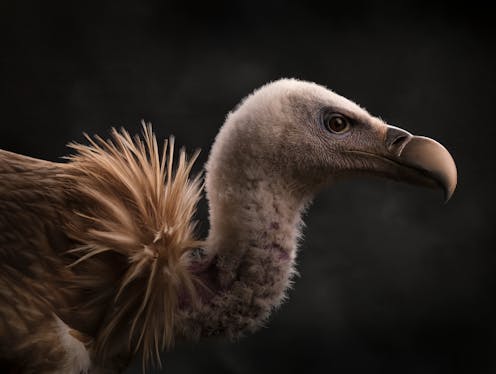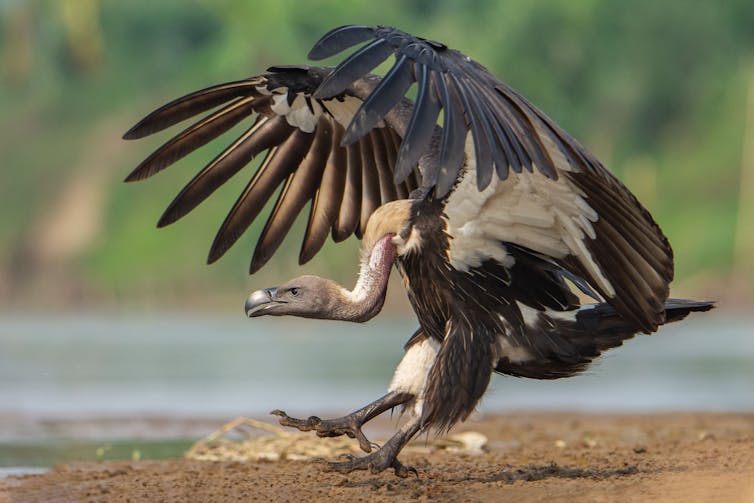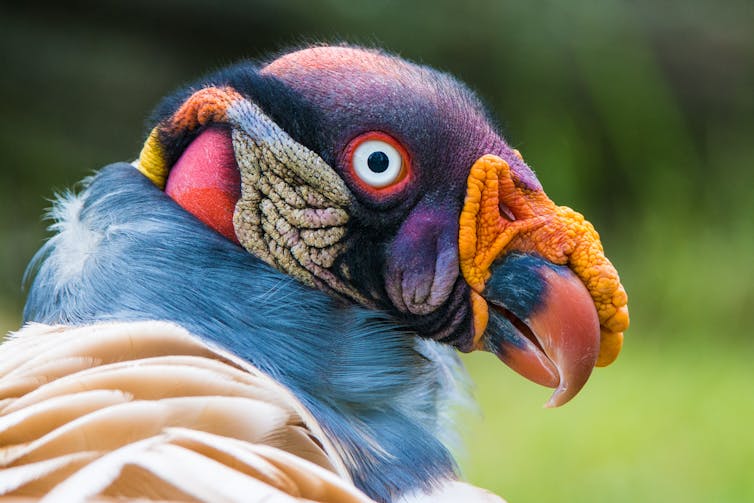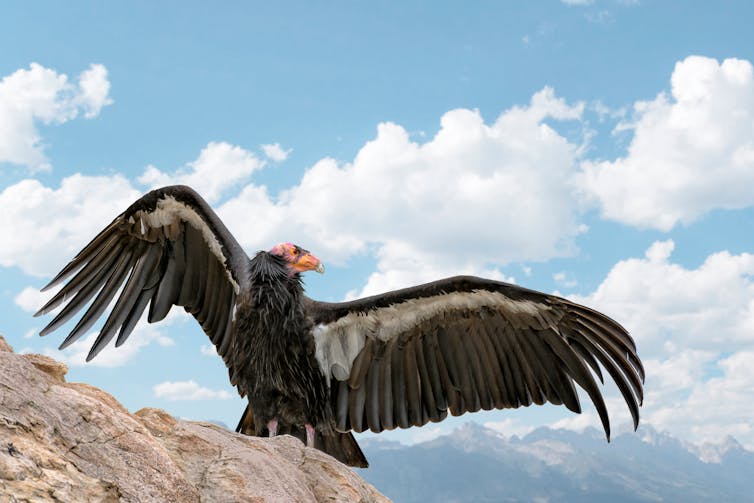
With their long, featherless necks and stern-looking faces, vultures are an easy target for people’s fear and loathing. In books and films, they usually appear as a forewarning of bad things to come. And they are often used to describe someone who benefits from the misfortune of others.
But vultures should be celebrated, rather than dreaded. They are more than harbingers of death. They are a symbol of hope and luck in places from Ghana to Chile to Tibet, and, if we let them, they can warn of environmental change and illegal activities.
There is no denying vultures are on the lookout for death. But this is a good thing. A group of vultures can pick a carcass clean within 20 minutes, meaning that any remains of the dead animal are not left to turn into a breeding ground for pathogens. This recycling process is vital in reducing the spread of diseases, including those that can be transmitted between animals and humans.
One study in Kenya found that where vultures were absent, carcasses are often hubs of infection. In the study, carcasses were placed in areas that were either visible (in the open) or not (under tree cover) to vultures. The study found animals’ bodies decomposed three times slower where vultures did not feed on a carcass. With their keen eyesight and flying skills, vultures can spot carrion faster than land scavengers. By the time land scavengers, such as hyenas and jackals, get to a carcass, it is likely to have been exposed to pathogens for longer.
In some places in India, feral dogs have increased in numbers where vultures have declined, which has led to an increase in human cases of rabies.
Warning signs
Vultures act as a sentinel species, which are animals that are more susceptible to hazards in a habitat than humans. Vultures consume any toxins a carcass may have carried. If these toxins are particularly dangerous, vultures that have fed on the chemical-filled body may struggle to reproduce, become ill or die. In this way, declines in vultures could highlight pollutants in the environment that may be harmful to many other species, including humans.
For example, diclofenac, an anti-inflammatory drug widely used in livestock, can kill vultures even in small quantities. Diclofenac can also pose a serious threat to aquatic animals, plants and mammals. It was banned in some South Asian countries after conservationists campaigned to raise awareness that diclofenac was the main cause of collapsing vulture populations.
Harmful chemicals have been a major cause of vulture population crashes across Europe, Africa and Asia. In some Asian countries, vultures have declined by 96% in the last ten years.

Wirestock Creators/Shutterstock
The feeding behaviour of vultures may offer us another warning beacon. Vultures search for food by soaring high in the sky. The presence of large circling groups usually signals there is a recently killed animal on the ground. This circling behaviour may indicate the remains of a poached animal, such as an elephant killed for its ivory or a rhino for its horn. In fact, vultures are often killed by poachers for that very reason: so as to avoid the authorities being alerted to their presence.
Spirituality
Some people associate vultures with morbidity, darkness, and gluttony. But in many cultures throughout history, vultures have spiritual and symbolic value. Nekhbet, the vulture goddess, was the protector of Upper Egypt and represented protection with her large wings.

Nick Fox/Shutterstock
Condors, a type of vulture found in the Americas, have been depicted in artwork across the Andean region of South America since 2500BC. They have long been associated with power, strength and wisdom. Today, condors are still viewed as the spirit of the Andes by indigenous peoples, and are the national bird of Bolivia, Chile, Colombia and Ecuador.
In Tibetan culture, vultures are viewed as sacred and holy. Dead community members are often taken to high altitudes so their corpses can be consumed by the birds. Tibetans believe the vultures take the remains of the body to the heavens, allowing the soul to be reincarnated.
In many cultures, vultures are a totem (an animal that acts as an emblem of a family or clan). For example, the totem of a clan in the Akan traditional area in Ghana is a vulture, symbolising calmness and patience.
Symbol of hope
Wildlife is declining at alarming rates globally and, as a wildlife conservationist, it is easy to feel despondent. But one vulture species provides a powerful reminder that conservation efforts can change the fate of species on the brink of extinction.

Barbara Ash/Shutterstock
In the 1980s, only 22 California condors remained in the wild. These last vultures were captured and taken into captivity, and by 1987 the species was declared extinct in the wild. But intensive conservation programmes have led to the reintroduction of California condors in California, Arizona and Baja California, Mexico. There are now at least 200 adults in the wild. This incredible bird is still taking scientists by surprise. In 2021, researchers found California condors can have been known to reproduce without mating.
While this species is not out of the woods yet, the California condor offers a symbol of hope for so many others.
For UK residents, vulture conservation may be an issue closer to home than people realise. There have been recent sightings of vultures in the UK, such as the bearded vulture in 2020 and Egyptian vulture in 2021, causing huge excitement among birdwatchers.
![]()
Esther Kettel does not work for, consult, own shares in or receive funding from any company or organisation that would benefit from this article, and has disclosed no relevant affiliations beyond their academic appointment.

